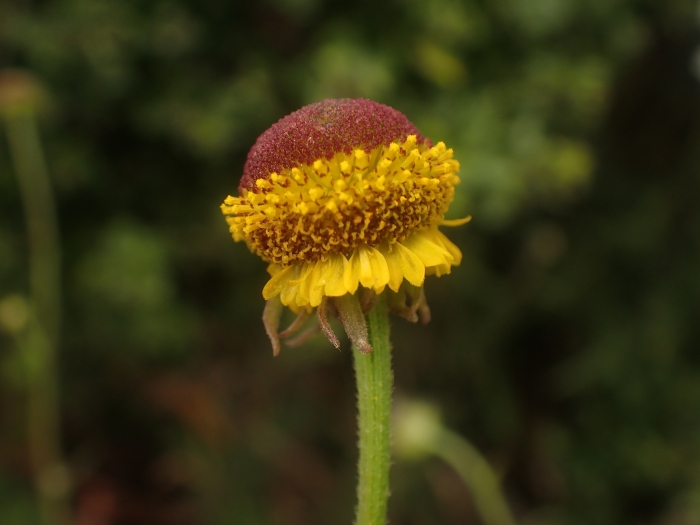Rosilla
(Helenium puberulum)
Rosilla (Helenium puberulum)
/
/

Cricket Raspet
CC BY 4.0
Image By:
Cricket Raspet
Recorded By:
Copyright:
CC BY 4.0
Copyright Notice:
Photo by: Cricket Raspet | License Type: CC BY 4.0 | License URL: http://creativecommons.org/licenses/by/4.0/ | Rights Holder: Cricket Raspet | Publisher: iNaturalist | Date Created: 2021-06-28T00:09:21Z |


















































Estimated Native Range
Summary
Helenium puberulum, commonly known as Rosilla, is a perennial herb that is native to the grasslands, meadows, and riparian zones of California and Baja California. It can reach up to 160 cm in height, though size can vary significantly. Rosilla is characterized by its lower foliage concentration and winged stems, which have flaps of tissue running down the sides. The plant is notable for its spherical flower heads, a unique feature within the Helenium genus, which typically produces conical heads. Each head may contain over 1000 small disc florets, starting yellow at the base and transitioning to brown or purple at the tips. Rosilla blooms in the late summer and fall, producing showy yellow and cream flowers that attract pollinators.
Rosilla is valued for its late-season blooms and ability to adapt to various garden settings. It is often used in naturalistic plantings, pollinator gardens, and as a border plant. While it prefers full sun, it can tolerate partial shade and requires moderate watering and well-drained soils. Gardeners should be aware that Helenium puberulum can be susceptible to powdery mildew and should ensure good air circulation around the plants to mitigate this issue. Despite its beauty, it is not commonly found in cultivation, but it can be a unique addition to a garden that supports native flora and fauna.CC BY-SA 4.0
Rosilla is valued for its late-season blooms and ability to adapt to various garden settings. It is often used in naturalistic plantings, pollinator gardens, and as a border plant. While it prefers full sun, it can tolerate partial shade and requires moderate watering and well-drained soils. Gardeners should be aware that Helenium puberulum can be susceptible to powdery mildew and should ensure good air circulation around the plants to mitigate this issue. Despite its beauty, it is not commonly found in cultivation, but it can be a unique addition to a garden that supports native flora and fauna.CC BY-SA 4.0
Plant Description
- Plant Type: Herb
- Height: 0.5-3 feet
- Width: 0.5-3 feet
- Growth Rate: Moderate
- Flower Color: Yellow, Cream
- Flowering Season: Fall, Summer
- Leaf Retention: Deciduous
Growth Requirements
- Sun: Full Sun
- Water: Medium
- Drainage: Medium
Common Uses
Bee Garden, Bird Garden, Butterfly Garden, Deer Resistant, Hummingbird Garden, Low Maintenance, Rabbit Resistant
Natural Habitat
native to the grasslands, meadows, and riparian zones of California and Baja California
Other Names
Common Names: Sneezewort, Rosilla-Solbrud
Scientific Names: , Helenium puberulum, Helenium californicum, Helenium mexicanum, Cephalophora decurrens, Heleniastrum puberulum, Helenium puberulum var. bigelowii, Helenium puberulum var. puberulum,
GBIF Accepted Name: Helenium puberulum DC.